花生(peanut)分析
- 格式:ppt
- 大小:1.82 MB
- 文档页数:83
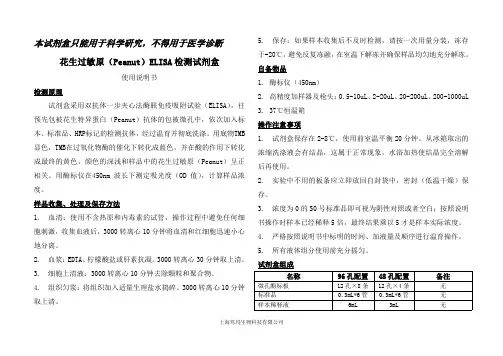
本试剂盒只能用于科学研究,不得用于医学诊断花生过敏原(Peanut)ELISA检测试剂盒使用说明书检测原理试剂盒采用双抗体一步夹心法酶联免疫吸附试验(ELISA)。
往预先包被花生特异蛋白(Peanut)抗体的包被微孔中,依次加入标本、标准品、HRP标记的检测抗体,经过温育并彻底洗涤。
用底物TMB 显色,TMB在过氧化物酶的催化下转化成蓝色,并在酸的作用下转化成最终的黄色。
颜色的深浅和样品中的花生过敏原(Peanut)呈正相关。
用酶标仪在450nm波长下测定吸光度(OD值),计算样品浓度。
样品收集、处理及保存方法1.血清:使用不含热原和内毒素的试管,操作过程中避免任何细胞刺激,收集血液后,3000转离心10分钟将血清和红细胞迅速小心地分离。
2.血浆:EDTA、柠檬酸盐或肝素抗凝。
3000转离心30分钟取上清。
3.细胞上清液:3000转离心10分钟去除颗粒和聚合物。
4.组织匀浆:将组织加入适量生理盐水捣碎。
3000转离心10分钟取上清。
5.保存:如果样本收集后不及时检测,请按一次用量分装,冻存于-20℃,避免反复冻融,在室温下解冻并确保样品均匀地充分解冻。
自备物品1.酶标仪(450nm)2.高精度加样器及枪头:0.5-10uL、2-20uL、20-200uL、200-1000uL3.37℃恒温箱操作注意事项1.试剂盒保存在2-8℃,使用前室温平衡20分钟。
从冰箱取出的浓缩洗涤液会有结晶,这属于正常现象,水浴加热使结晶完全溶解后再使用。
2.实验中不用的板条应立即放回自封袋中,密封(低温干燥)保存。
3.浓度为0的S0号标准品即可视为阴性对照或者空白;按照说明书操作时样本已经稀释5倍,最终结果乘以5才是样本实际浓度。
4.严格按照说明书中标明的时间、加液量及顺序进行温育操作。
5.所有液体组分使用前充分摇匀。
试剂盒组成名称96孔配置48孔配置备注微孔酶标板12孔×8条12孔×4条无标准品0.3mL*6管0.3mL*6管无样本稀释液6mL3mL无上海笃玛生物科技有限公司检测抗体-HRP10mL5mL无20×洗涤缓冲液25mL15mL按说明书进行稀释底物A6mL3mL无底物B6mL3mL无终止液6mL3mL无封板膜2张2张无说明书1份1份无自封袋1个1个无注:标准品(S0-S5)浓度依次为:0、1.25、2.5、5、10、20ppm试剂的准备20×洗涤缓冲液的稀释:蒸馏水按1:20稀释,即1份的20×洗涤缓冲液加19份的蒸馏水。
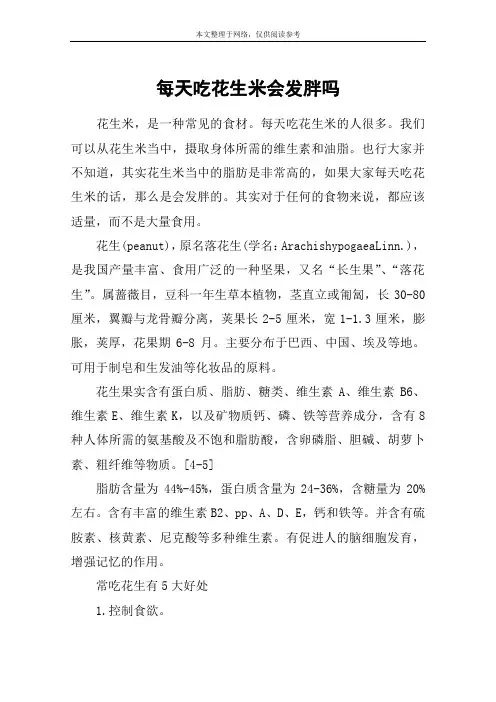
每天吃花生米会发胖吗花生米,是一种常见的食材。
每天吃花生米的人很多。
我们可以从花生米当中,摄取身体所需的维生素和油脂。
也行大家并不知道,其实花生米当中的脂肪是非常高的,如果大家每天吃花生米的话,那么是会发胖的。
其实对于任何的食物来说,都应该适量,而不是大量食用。
花生(peanut),原名落花生(学名:ArachishypogaeaLinn.),是我国产量丰富、食用广泛的一种坚果,又名“长生果”、“落花生”。
属蔷薇目,豆科一年生草本植物,茎直立或匍匐,长30-80厘米,翼瓣与龙骨瓣分离,荚果长2-5厘米,宽1-1.3厘米,膨胀,荚厚,花果期6-8月。
主要分布于巴西、中国、埃及等地。
可用于制皂和生发油等化妆品的原料。
花生果实含有蛋白质、脂肪、糖类、维生素A、维生素B6、维生素E、维生素K,以及矿物质钙、磷、铁等营养成分,含有8种人体所需的氨基酸及不饱和脂肪酸,含卵磷脂、胆碱、胡萝卜素、粗纤维等物质。
[4-5]脂肪含量为44%-45%,蛋白质含量为24-36%,含糖量为20%左右。
含有丰富的维生素B2、pp、A、D、E,钙和铁等。
并含有硫胺素、核黄素、尼克酸等多种维生素。
有促进人的脑细胞发育,增强记忆的作用。
常吃花生有5大好处1.控制食欲。
花生是“高饱腹感”食物,能让你感觉更饱,或者饱的时间更长。
发表在《营养与代谢》期刊上的一篇文章发现,用花生当零食的人吃得更少。
美国普度大学营养科学系教授马特斯博士说:“花生的高饱腹感并不仅仅是脂肪、膳食纤维和蛋白质含量的原因,而是所有因素协同作用的结果。
”布莱根妇女医院营养系主任凯西·麦克马纳斯说,如果在早餐时吃花生或花生酱,就能减少这一天的进食量。
2.有助减盐。
咸味零食通常是高盐食物。
但咸味花生的盐含量,比同样重量的切片面包、冰冻华夫饼还要少。
因此,咸味花生不但能满足你吃咸的爱好,还不容易导致摄入食盐过量。
3.稳定血糖。
研究发现,如果人们把饮食中的一份红肉换成花生,患糖尿病的风险会降低21%。

许地山《落花生》翻译赏析许地山《落花生》翻译赏析(张培基译)原文:落花生许地山我们屋后有半亩隙地。
母亲说:“让它荒芜着怪可惜,既然称们那么爱吃花生,就辟来做花生园罢。
”我们几姊弟和几个小丫头都很喜欢——买种的买种,动土的动土,灌园的灌园;过不了几个月,居然收获了!妈妈说:“今晚我们可以做一个收获节,也请你们爹爹来尝尝我们的新花生,如何”我们都答应了。
母亲把花生做成好几样食品,还吩咐这节期要在园里的茅亭举行。
那晚上的天色不大好,可是爹爹也到来,实在很难得!爹爹说:“你们爱吃花生么”我们都争着答应:“爱!”“谁能把花生的好处说出来”。
姊姊说:“花生的气味很美。
”哥哥说:“花生可以制油。
”我说:“无论何等人都可以用贱价买它来吃;都喜欢吃它。
这就是它的好处。
”爹爹说:“花生的用处固然很多;但有一样是很可贵的。
这小小的豆不像那好看的苹果、桃子、石榴,把它们的果实悬在枝上,鲜红嫩绿的颜色,令人一望而发生羡慕的心。
它只把果子埋在地的,等到成熟,才容人把它挖出来。
你们偶然看见一棵花生瑟缩地长在地上,不能立刻辨出它有没有果实,非得等到你接触它才能知道。
”我们都说:“是的。
”母亲也点点头。
爹爹接下去说:“所以你们要像花生,因为它是有用的,不是伟大、好看的东西。
”我说:“那么,人要做有用的人,不要做伟大、体面的人了。
”爹爹说:“这是我对于你们的希望。
”我们谈到夜阑才散,所有花生食品虽然没有了,然而父亲的话现在还印在我心版上。
译文:PeanutsBehind our house there lay half a mu of vacant land. Mother said, “It’s a pity to let it lie waste. Since you all like to eat peanuts so much, why not plant some here” That exhilarated us children and our servant girls as well, and soon we started buying seeds, ploughing the land and watering the plants. We gathered in a good harvest just after a couple of months!Mother said, “How about giving a party this evening to celebrate the harvest and inviting your Daddy to have a taste of our newly-harvested peanuts” We all agreed. Mother made quite a few varieties of goodies out of the peanuts, and told us that the party would be held in the thatched pavilion on the peanut plot.It looked like rain that evening, yet, to our great joy, father came nevertheless.Night sky is not very good, but the father has come, it is hard to come by.“Do you like peanuts” asked Father.“Yes, we do!” We vied in giving the answer.“Which of you could name the good things in peanuts” “Peanuts taste good,” said my elder sister.“Peanuts produce edible oil,” said my elder broth er.“Peanuts are so cheap,” said I, “that anyone can afford to eat them. Peanuts are everyone’s favorite. That’s why we call peanuts good.”“Peanuts are so cheap,” said I, “that anyone can afford to eat them. Peanuts are everyone’s favorite. That’s why we call peanuts good.”“It’s true that peanuts have many uses,” said Father, “but they’re most beloved in one respect. Unlike nice-looking apples, peaches and pomegranates, which hang their fruit on branches and win people’s instant admiration with their bril liant colours, tiny little peanuts bury themselves underground and remain unearthed until they’re ripe. When you come upon a peanut plant lying curled up on the ground, you can never immediately tell whether or not it bears any nuts until you touch them.”“That’s true,” we said in unison.Mother also nodded. “So you must take after peanuts,” Father continued, “because they’re useful though not great and nice-looking.”“Then you mean one should be useful rather than gre at and nice-looking,” I said.“That’s what I expect of you,” Father concluded.We kept chatting until the party broke up late at night. Today, though nothing is left of the goodies made of peanuts, Father’s words remain engraved in my mind.译文赏析:就原文而言,作者用朴实的语言记录了自己生活中的一个小故事,朴素、清新。
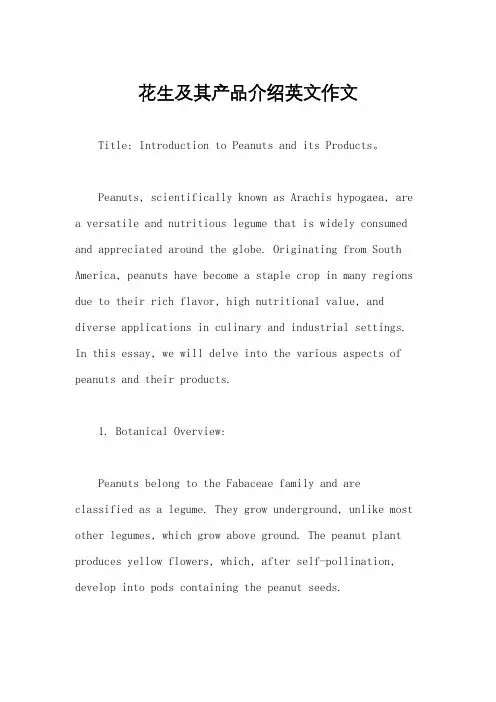
花生及其产品介绍英文作文Title: Introduction to Peanuts and its Products。
Peanuts, scientifically known as Arachis hypogaea, are a versatile and nutritious legume that is widely consumed and appreciated around the globe. Originating from South America, peanuts have become a staple crop in many regions due to their rich flavor, high nutritional value, and diverse applications in culinary and industrial settings. In this essay, we will delve into the various aspects of peanuts and their products.1. Botanical Overview:Peanuts belong to the Fabaceae family and are classified as a legume. They grow underground, unlike most other legumes, which grow above ground. The peanut plant produces yellow flowers, which, after self-pollination, develop into pods containing the peanut seeds.2. Nutritional Value:Peanuts are a powerhouse of essential nutrients. They are rich in protein, healthy fats, fiber, vitamins, and minerals. A 100-gram serving of peanuts provides approximately 25 grams of protein, making them an excellent plant-based protein source for vegetarians and vegans. Additionally, peanuts contain monounsaturated and polyunsaturated fats, which are beneficial for heart health. They are also a good source of folate, niacin, vitamin E, and several minerals, including magnesium, phosphorus, and potassium.3. Culinary Uses:Peanuts are incredibly versatile in the kitchen and can be enjoyed in various forms. They are commonly consumed roasted or boiled as a snack. Peanut butter, a creamyspread made from ground peanuts, is a beloved condimentused in sandwiches, desserts, and savory dishes. Peanut oil, extracted from peanuts, is widely used in cooking due toits high smoke point and mild flavor. In Asian cuisines,peanuts are often used in stir-fries, sauces, and noodle dishes, adding texture and flavor to the recipes.4. Industrial Applications:Peanuts and their by-products have numerous industrial applications. Peanut oil serves as a key ingredient in cosmetics, soaps, and pharmaceuticals due to its moisturizing and emollient properties. Peanut shells, the outer covering of peanuts, are utilized in the production of animal feed, biomass fuel, and compost. Furthermore, peanut meal, a by-product of oil extraction, is used as a protein-rich supplement in livestock feed.5. Health Benefits:Including peanuts in your diet offers various health benefits. The high protein content of peanuts helps in muscle repair and growth, making them an excellent post-workout snack. The monounsaturated fats present in peanuts contribute to lowering bad cholesterol levels, thus reducing the risk of heart disease. Peanuts also containantioxidants such as resveratrol, which have anti-inflammatory properties and may reduce the risk of chronic diseases like cancer and diabetes when consumed as part of a balanced diet.6. Environmental Impact:The cultivation of peanuts can have both positive and negative environmental effects. On one hand, peanuts are nitrogen-fixing plants, which means they improve soil fertility by converting atmospheric nitrogen into a form that plants can use. This reduces the need for synthetic fertilizers, thus minimizing environmental pollution. However, large-scale peanut farming can lead to deforestation, habitat loss, and soil erosion if not managed sustainably. Therefore, it is essential for peanut producers to adopt practices that prioritize soil conservation and biodiversity preservation.In conclusion, peanuts are a versatile legume with a wide range of culinary, nutritional, and industrial applications. Whether enjoyed as a snack, incorporated intorecipes, or used in various industrial processes, peanuts continue to be valued for their flavor, nutrition, and utility. Moreover, as awareness of their health benefits and environmental impact grows, efforts to promote sustainable peanut production and consumption are becoming increasingly important.。
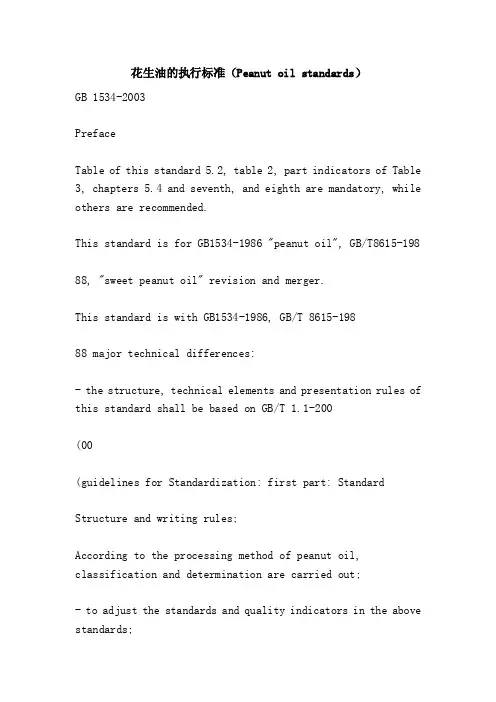
花生油的执行标准(Peanut oil standards)GB 1534-2003PrefaceTable of this standard 5.2, table 2, part indicators of Table 3, chapters 5.4 and seventh, and eighth are mandatory, while others are recommended.This standard is for GB1534-1986 "peanut oil", GB/T8615-19888, "sweet peanut oil" revision and merger.This standard is with GB1534-1986, GB/T 8615-19888 major technical differences:- the structure, technical elements and presentation rules of this standard shall be based on GB/T 1.1-200(00(guidelines for Standardization: first part: StandardStructure and writing rules;According to the processing method of peanut oil, classification and determination are carried out;- to adjust the standards and quality indicators in the above standards;- revised the relevant index value in the quality index.This standard has been revised in accordance with the international Codex Alimentarius Commission standards.This standard since the date of implementation, instead of GB1534-1986 "peanut oil", GB/T8615-1988 ((aromatic peanut oil).This standard is put forward by National Grain Bureau and put in order.This standard is responsible for drafting units: National Grain Bureau standard quality center, State Food Bureau, Xi'an food and feed quality supervision and inspectionTest center; in the drafting unit: Shandong Laiyang Luhua peanut oil Co. Ltd., Qingdao Kerry Vegetable Oil Co. Ltd. and Shanghai Fulinmen Food Co.Ltd, Shenzhen Nanshun Oil Co. ltd..The main drafters of this standard are Tang Ruiming, dragon, Xue Yalin, Chen Yan, Sun Dongwei, Pang Dongmei, Xu Xia, Xia Hongwen.All previous editions of the standard replaced by this standard are: GB1534-1986, GB/T8615-1988,GB 1534-2003Peanut oilRangeThis standard specifies the terms and definitions, classification, quality requirements, testing methods and rules, specifications, labels, packaging, storage and transportation of peanut oilRequirement。
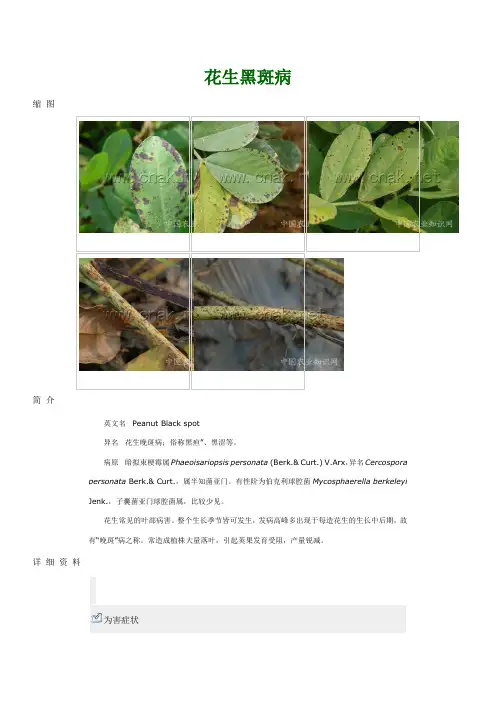
花生黑斑病缩图简介英文名Peanut Black spot异名花生晚斑病;俗称黑疸”、黑涩等。
病原暗拟束梗霉属Phaeoisariopsis personata (Berk.& Curt.) V.Arx,异名Cercospora personata Berk.& Curt.,属半知菌亚门。
有性阶为伯克利球腔菌Mycosphaerella berkeleyiJenk.,子囊菌亚门球腔菌属,比较少见。
花生常见的叶部病害。
整个生长季节皆可发生,发病高峰多出现于每造花生的生长中后期,故有“晚斑”病之称。
常造成植株大量落叶,引起荚果发育受阻,产量锐减。
详细资料为害症状黑斑病的症状与褐斑病大致相似,为害部分相同,两者可同时混合发生。
(1)叶片:黑斑病病斑比褐斑病小,直径1~5毫米,近圆形或圆形,暗褐色至黑褐色,叶片正反两面颜色相近。
病斑周围通常没有黄色晕圈,或有较窄、不明显的淡黄色晕圈。
在叶背面病斑上,通常产生许多黑色小点,即病菌子座,呈同心轮纹状,并有一层灰褐色霉状物,即病菌分生孢子梗和分生孢子。
病害严重时,产生大量病斑,引起叶片干枯脱落。
(2)叶柄和茎杆:病斑椭圆形,黑褐色,病斑多时连成不规则大斑,严重的整个叶柄和茎杆变黑枯死。
病原物(1)形态:①分生孢子梗。
丛生,粗短,聚生于分生孢子座上,多数无隔膜,末端屈曲,褐色至暗褐色,大小(24~54)×(5~8)微米。
②分生孢子。
倒棒状,较粗短,橄榄色,多胞,具1~8个隔膜,多为3~5个隔膜,大小(18~60)微米×(5~11)微米。
(2)特性:病菌生长适温为25~28℃,并需要高湿,高湿更有利于产孢和孢子萌发。
侵染循环(1)菌源:病原以菌丝体或分孢座随病残体遗落土中越冬,或以分生孢子粘附在种荚、茎杆表面越冬。
(2)传播:第2年合适条件时,越冬分生孢子或菌丝直接产生的分生孢子随风雨传播,为初侵染与再侵接种体,从寄主表皮或气孔侵入致病。
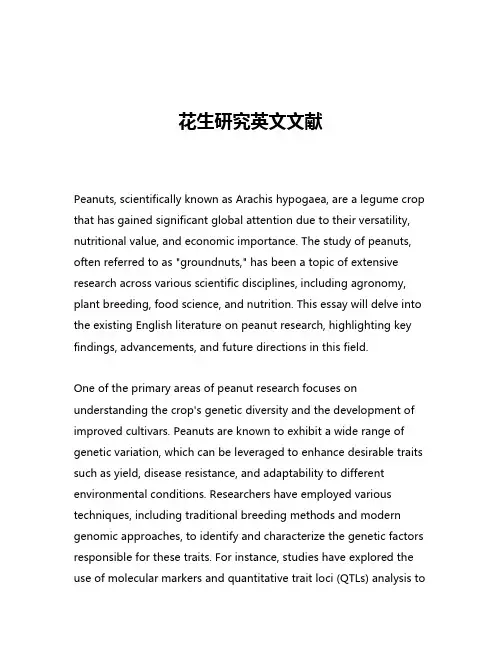
花生研究英文文献Peanuts, scientifically known as Arachis hypogaea, are a legume crop that has gained significant global attention due to their versatility, nutritional value, and economic importance. The study of peanuts, often referred to as "groundnuts," has been a topic of extensive research across various scientific disciplines, including agronomy, plant breeding, food science, and nutrition. This essay will delve into the existing English literature on peanut research, highlighting key findings, advancements, and future directions in this field.One of the primary areas of peanut research focuses on understanding the crop's genetic diversity and the development of improved cultivars. Peanuts are known to exhibit a wide range of genetic variation, which can be leveraged to enhance desirable traits such as yield, disease resistance, and adaptability to different environmental conditions. Researchers have employed various techniques, including traditional breeding methods and modern genomic approaches, to identify and characterize the genetic factors responsible for these traits. For instance, studies have explored the use of molecular markers and quantitative trait loci (QTLs) analysis todissect the genetic architecture of peanut yield components, oil content, and resistance to major diseases like leaf spot and aflatoxin contamination.Another significant aspect of peanut research is the investigation of the crop's nutritional profile and potential health benefits. Peanuts are renowned for their high protein content, as well as their abundance of essential vitamins, minerals, and bioactive compounds. Researchers have conducted extensive studies to evaluate the nutritional composition of different peanut cultivars, examining factors such as fatty acid profiles, antioxidant activity, and the presence of beneficial phytochemicals. These findings have important implications for the development of nutritionally-enhanced peanut products and the promotion of peanuts as a healthy food choice.In the realm of food science, peanut research has focused on exploring the processing and utilization of peanuts in various food applications. Researchers have investigated methods for improving the quality, shelf-life, and safety of peanut-based products, such as peanut butter, roasted peanuts, and peanut oil. This includes studying the effects of different processing techniques, the role of packaging materials, and the mitigation of food safety concerns like aflatoxin contamination. Additionally, researchers have explored the potential for value-added peanut products, such as the developmentof peanut-based protein isolates, flours, and other ingredients for use in the food industry.Peanut research has also addressed the agronomic and environmental aspects of peanut cultivation. Researchers have examined the optimal growing conditions, water management strategies, and nutrient requirements for peanut production, aiming to enhance yield and sustainability. Studies have also delved into the impact of climate change on peanut cultivation, exploring strategies for adapting to shifting environmental conditions and mitigating the effects of drought, heat stress, and other abiotic stresses.Furthermore, peanut research has contributed to the understanding of the crop's role in agricultural systems and its potential for sustainable development. Peanuts are known for their ability to fix atmospheric nitrogen through symbiotic relationships with soil microorganisms, making them a valuable component of crop rotation and intercropping practices. Researchers have investigated the agronomic and environmental benefits of integrating peanuts into diverse farming systems, examining their impact on soil fertility, greenhouse gas emissions, and the overall sustainability of agricultural production.In recent years, the emergence of advanced technologies, such as precision agriculture, remote sensing, and machine learning, hassignificantly enhanced peanut research. These tools have enabled researchers to collect and analyze large-scale data on peanut growth, yield, and environmental interactions, leading to the development of more efficient and data-driven management strategies. Additionally, the application of biotechnology and genetic engineering has opened up new avenues for peanut improvement, including the development of disease-resistant cultivars, the enhancement of nutritional profiles, and the exploration of novel uses for peanut-derived products.Despite the substantial progress made in peanut research, there are still numerous challenges and opportunities that warrant further investigation. For instance, the continued efforts to address the issue of aflatoxin contamination, a major food safety concern associated with peanuts, remain a priority. Researchers are exploring various strategies, such as the development of resistant cultivars, improved post-harvest handling practices, and the use of biological control agents, to mitigate this problem.Another area of growing interest is the exploration of peanut's potential as a sustainable and versatile crop for biofuel production. Peanut oil has been identified as a promising feedstock for biodiesel, and researchers are investigating the feasibility and environmental impacts of using peanut-derived fuels as alternatives to fossil fuels.Furthermore, as consumer preferences and dietary trends evolve, peanut research is also shifting towards the development of innovative peanut-based food products that cater to diverse dietary needs and preferences, such as gluten-free, vegan, and allergen-free options.In conclusion, the existing English literature on peanut research showcases the multifaceted and dynamic nature of this field. From genetic improvement and nutritional analysis to food processing and sustainable agriculture, peanut research has made significant contributions to our understanding of this important legume crop. As the global demand for peanuts continues to grow, the ongoing research efforts in this area will be crucial in addressing the challenges and seizing the opportunities that lie ahead, ultimately enhancing the production, utilization, and sustainability of peanuts worldwide.。
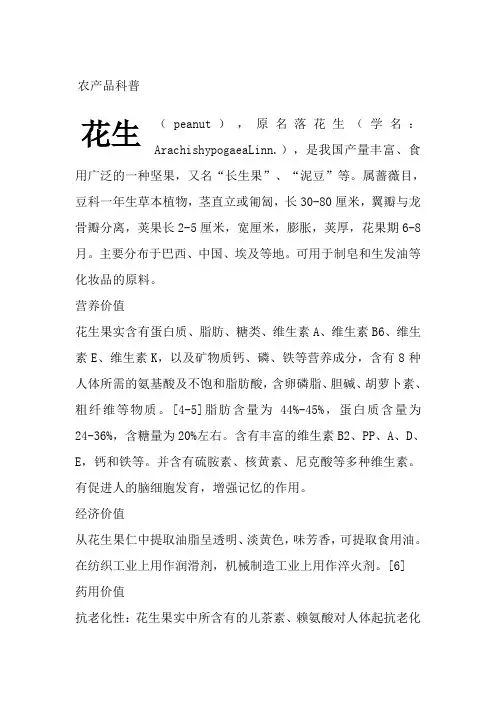

摘要花生(Peanut)是一种重要的经济作物,除用于榨油外,还可直接食用。
在我国种植区域广阔,除西藏、青海、宁夏少数省区外,它在华北平原、渤海湾沿岸、华南沿海及四川盆地等都被广泛种植。
花生中所含的白藜芦醇(Resveratrol 略写为Res),是具有多种药理作用和生物活性的化合物,具有抗菌抗炎、抗氧化、预防心脏病、抗癌、抗血小板凝聚、保护肝脏、免疫调节、防辐射、雌激素作用、抗艾滋活性等,被誉为21世纪最有前途的抗癌药物之一,广泛应用于食品、医药、保健品、化妆品、食品添加剂等领域,具有重要的研究和开发价值。
目前市售的白藜芦醇及其制品,主要来源于从如虎杖、葡萄等植物中提取(这句话好像不完整)。
本文以花生植株为试验材料,较为系统地研究了花生植株的生物技术和次生代谢产物Res的提取、分离纯化工艺:进行愈伤组织诱导培养、摇瓶悬浮培养;建立花生细胞摇瓶悬浮培养的结构化动力学模型;研究诱导子对花生细胞生长和白藜芦醇积累的影响;进行花生细胞生物反应器悬浮培养的初步扩大试验;通过二次通用旋转组合试验设计方法优化超声波提取花生根中白藜芦醇的和大孔树脂纯化花生根中白藜芦醇的最佳工艺条件。
主要研究结果如下:1.在愈伤组织诱导培养中,培养基种类、外植体类型和激素配比对愈伤组织诱导及白藜芦醇含量有显著影响。
通过三元二次通用旋转试验确定愈伤组织诱导培养的最佳激素配比,从而得到最适培养基是:MS+2.50 mg/L 2,4-D+1.80 mg/L KT+3.00 mg/L 6-BA。
高产白藜芦醇花生细胞系生物量最大达到43.95 g/L,白藜芦醇产量最大达到9.07 mg/g。
2.悬浮培养过程中研究了摇床转速、接种量、pH和蔗糖浓度对悬浮细胞增殖倍数的影响。
通过四元二次通用旋转试验确定悬浮培养的优化条件为:摇床转速130 r/min,接种量38.00 g/L,pH5.80,蔗糖浓度40.00 g/L。
测定了培养过程中细胞组织的蛋白质含量、苯丙氨酸转氨酶活性、过氧化物酶活性,它们的变化都在一定程度上反映了悬浮细胞生长及白藜芦醇含量变化情况。
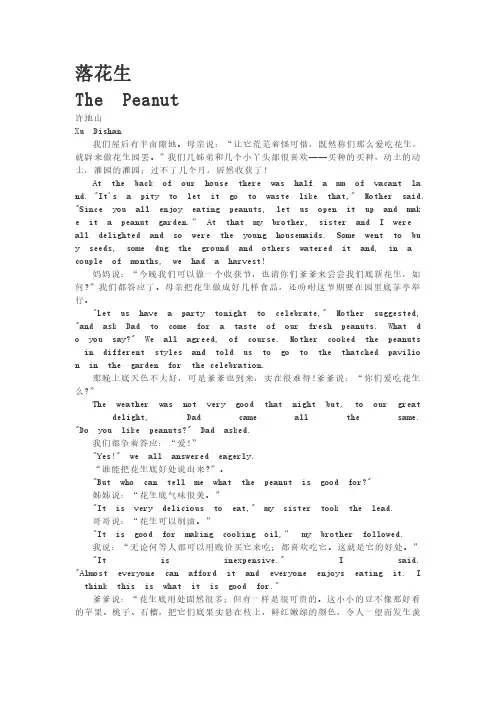
落花生The Peanut许地山Xu Dishan我们屋后有半亩隙地。
母亲说:“让它荒芜着怪可惜,既然称们那么爱吃花生,就辟来做花生园罢。
”我们几姊弟和几个小丫头都很喜欢——买种的买种,动土的动土,灌园的灌园;过不了几个月,居然收获了!At the back of our house there was half a mu of vacant la nd."It's a pity to let it go to waste like that,"Mother said. "Since you all enjoy eating peanuts,let us open it up and mak e it a peanut garden.”At that my brother,sister and I wereall delighted and so were the young housemaids.Some went to bu y seeds,some dug the ground and others watered it and,in a couple of months,we had a harvest!妈妈说:“今晚我们可以做一个收获节,也请你们爹爹来尝尝我们底新花生,如何?”我们都答应了。
母亲把花生做成好几样食品,还吩咐这节期要在园里底茅亭举行。
"Let us have a party tonight to celebrate,"Mother suggested, "and ask Dad to come for a taste of our fresh peanuts.What d o you say?"We all agreed,of course.Mother cooked the peanuts in different styles and told us to go to the thatched pavilio n in the garden for the celebration.那晚上底天色不大好,可是爹爹也到来,实在很难得!爹爹说:“你们爱吃花生么?”The weather was not very good that night but,to our great delight,Dad came all the same. "Do you like peanuts?"Dad asked.我们都争着答应:“爱!”"Yes!"we all answered eagerly.“谁能把花生底好处说出来?”。
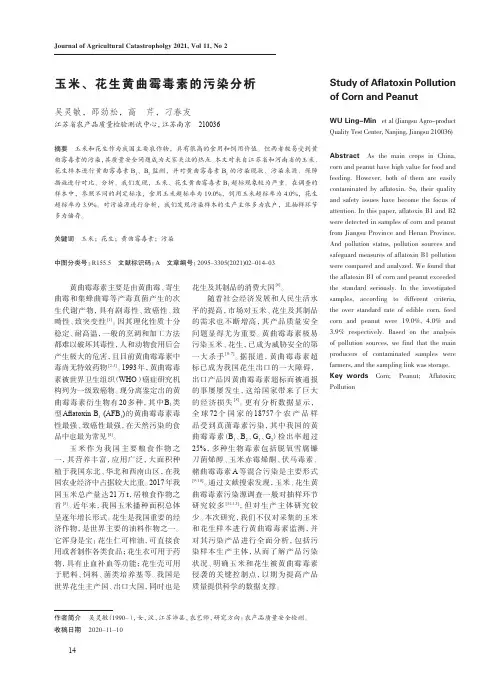
peanut词根词缀
(实用版)
目录
1.引言:介绍花生以及花生的英文单词“peanut”
2.词根词缀的定义与作用
3.“peanut”的词根词缀分析
4.花生与“peanut”的关联
5.结论:总结花生和“peanut”的词根词缀含义
正文
花生,学名为 Arachis hypogaea,是一种常见的豆科植物,其果实为荚果,种子即花生米,通常被用作食物。
在英文中,花生被称为“peanut”。
词根词缀,是词汇构成的基本元素,它们承载着词汇的意义和词性信息。
通过分析词根词缀,我们可以更好地理解和记忆单词。
“peanut”这个词的词根词缀分析,可以发现它主要由两部分组成:“pea”和“nut”。
其中,“pea”意为“豆子”,“nut”则表示“坚果”。
这两部分结合在一起,代表了花生这种植物的果实特点:它的种子像豆子一样,但外壳却类似于坚果。
花生与“peanut”之间的关联,不仅体现在它们的形态特征上,也体现在它们的营养价值和用途上。
花生富含蛋白质、脂肪和多种维生素,可以作为零食,也可以用于烹饪。
而“peanut”这个词,正是描述这种独特的植物的英文名称。
总的来说,“peanut”这个词的词根词缀分析,既揭示了花生的特点,也展示了英语词汇的构成规律。
第1页共1页。